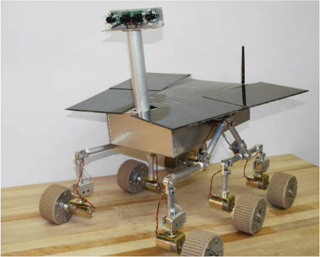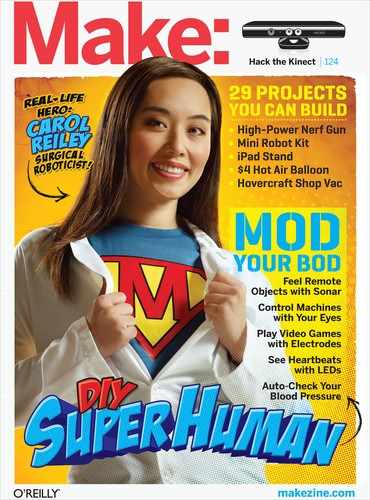
READER INPUT
Robot Girls, DIY View-Master, and Arduino Hype
![]() My daughters and I enjoy MAKE. It always inspires us. Over the last year or so, Camille (11) and Genevieve (9) and I have been hard at work building robots. We’ve built over ten so far. The girls are involved in the designing, naming, soldering, electronics, metal fabrication, programming, and testing of the robots, with Dad guiding the way.
My daughters and I enjoy MAKE. It always inspires us. Over the last year or so, Camille (11) and Genevieve (9) and I have been hard at work building robots. We’ve built over ten so far. The girls are involved in the designing, naming, soldering, electronics, metal fabrication, programming, and testing of the robots, with Dad guiding the way.
Our two most recent robots are a Mars Rover, complete with NASA-style rocker-bogie suspension system, and a mechatronic tank with Mecanum wheels (see videos of both at beatty-robotics.com). We’ve also built quadrotors, crawlers, and others. I thought you might like seeing some of our creations.
—Robert Beatty, Asheville, N.C.
![]() I was thrilled to see Bob Knetzger’s article “Mastering 3D Views” in MAKE Volume 28. I’m an avid user of the View-Master Personal Stereo Camera system to make my own View-Master reels. However, I was crushed when I read that “the empty View-Master reels aren’t made anymore.”
I was thrilled to see Bob Knetzger’s article “Mastering 3D Views” in MAKE Volume 28. I’m an avid user of the View-Master Personal Stereo Camera system to make my own View-Master reels. However, I was crushed when I read that “the empty View-Master reels aren’t made anymore.”
It is possible to get empty VM reels — I make them! I got frustrated at the expense of buying old reels on eBay, so in 2005 I started shipping new reels under my label Fresa Volante (fresavolante.com).
—Nick Merz, San Francisco
![]() View-Master: my favorite subject. Readers might want to know that you can get aftermarket reel blanks from Fresa Volante and old blank reel stock on eBay. View-Master’s blank reel machine operated until 2000, and in its last year they saw a dramatic increase in demand, since word got out they were mothballing the machine. People stocked up and are still selling their excess.
View-Master: my favorite subject. Readers might want to know that you can get aftermarket reel blanks from Fresa Volante and old blank reel stock on eBay. View-Master’s blank reel machine operated until 2000, and in its last year they saw a dramatic increase in demand, since word got out they were mothballing the machine. People stocked up and are still selling their excess.

At my website, vmresource.com you can find a template for formatting digital images for the original blank, instructions for modifying the cameras for electronic flash, and other tips and tricks (plus a PDF of the manual).
Also: although William Gruber was a genius and developed the View-Master format, most of the camera design and the Personal Stereo system were developed by two other geniuses named Gordon Smith and Karl Kurtz.
—Eddie Bowers, Dallas
![]() Thanks for the awesome projects. Here’s a Spoon Carving Knife I made (Volume 27), and the Gravity Catapult I built this week (Volume 28).
Thanks for the awesome projects. Here’s a Spoon Carving Knife I made (Volume 27), and the Gravity Catapult I built this week (Volume 28).
—Lucas Fried, 12, Wayland, Mass.


![]() Thank you for the excellent article “Balsa Dreams” by Andrew Leonard (Volume 28). It brought back great childhood memories of building model kits with my dad. Dad started me off on stick gliders, moving up to rubber-powered kits and eventually radio control. There were even a few control-line flights. It was a tense moment every time a new one would take to the air, as we didn’t want to see hours of work come crashing to the ground.
Thank you for the excellent article “Balsa Dreams” by Andrew Leonard (Volume 28). It brought back great childhood memories of building model kits with my dad. Dad started me off on stick gliders, moving up to rubber-powered kits and eventually radio control. There were even a few control-line flights. It was a tense moment every time a new one would take to the air, as we didn’t want to see hours of work come crashing to the ground.
Here’s a picture of us at the kitchen table in the late 1980s, covering the same Cessna that Leonard wrote about. All the memories came back: unfolding the plans and tissue, setting the windscreen and wheels aside for later, and laying out the parts on wax paper that was rolled out over the plans.
We each still build models to this day and make the pilgrimage every year to Toledo, Ohio, for the big radio control show to get primed for the next season of building and flying.
—Colin Rickards, Hamilton, Ontario
![]() I really liked Volume 25. It showed me ways to get started with Arduino microcontrollers (“Primer: Make and Use an Arduino”) and informed me of a programming software that’s visual like Lego Mindstorms (“Modkit: Drag-and-Drop Arduino Programming”). I’m now thinking about getting an Arduino and making projects I didn’t think I could possibly make. Thanks!
I really liked Volume 25. It showed me ways to get started with Arduino microcontrollers (“Primer: Make and Use an Arduino”) and informed me of a programming software that’s visual like Lego Mindstorms (“Modkit: Drag-and-Drop Arduino Programming”). I’m now thinking about getting an Arduino and making projects I didn’t think I could possibly make. Thanks!
—Ethan Durrant, San Francisco
![]() I’m writing for all of us who don’t use Arduinos but are still able to make and program amazing devices. I’m seeing the magazine drastically gravitating to Arduino (all variations are sold in the Maker Shed … hmm). It doesn’t matter what microcontroller you use; creating what you want is ultimately more important. It’s time to stop overhyping Arduino’s impact and provide options and alternatives with their advantages and disadvantages — such as the BASIC Stamp, Parallax Propeller, Pololu Orangutan series, or Wiring Microcontroller (the original Arduino).
I’m writing for all of us who don’t use Arduinos but are still able to make and program amazing devices. I’m seeing the magazine drastically gravitating to Arduino (all variations are sold in the Maker Shed … hmm). It doesn’t matter what microcontroller you use; creating what you want is ultimately more important. It’s time to stop overhyping Arduino’s impact and provide options and alternatives with their advantages and disadvantages — such as the BASIC Stamp, Parallax Propeller, Pololu Orangutan series, or Wiring Microcontroller (the original Arduino).
And what ever happened to the official MAKE Controller Kit? It seems to have faded into obscurity by your own doing.
—Will Cannady, Bronx, N.Y.
PROJECTS EDITOR KEITH HAMMOND REPLIES: We’re fans of all kinds of microcontrollers. In MAKE Volume 25 we compared eight different micros, including BASIC Stamp 2, PICAXE, and Propeller (“Getting Started with Microcontrollers”). Arduino is hot and people are excited by the possibilities. The hype will diminish over time. But Arduino is cheap, beginner-friendly, and has a huge code base, which is why it’s many makers’ first choice.
The MAKE Controller Kit (makershed.com #MKMT3) is good for complex projects, with its integrated networking and driver circuitry. But since 2010, the Netduino (#MKND01) has been a very successful alternative.
MAKE AMENDS
In Volume 27’s “Yellow Drum Machine,” the AXE020’s pins O0–O7 have their outputs (white) on the left, and +5V (red) on the right. The corrected diagram is online at makeprojects.com/project/y/1077.
In Volume 27’s “Roomba Recon,” the Linksys WRT-SL54GS router is hard to find and resists substitution. We apologize for any frustration, and hope to document an alternative.
In Volume 28’s “Toolbox,” John Baichtal’s supersoaker review was misattributed to Jason Babler. Sorry, J.B.!
In Volume 28’s “Coffee Table MAME Console,” the arcade buttons can be OSBF-30 or OSBF-24. Also, quick disconnects are a nice upgrade from spade connectors: 0.187" for joystick, and 0.110" for buttons.


